The soft focus
Petzval-type lenses reigned supreme in portraiture photography from its release in 1841 until the late 19th century. For photographers of those days, its brightness largely outweighed its small field of sharpness – only central. At that time, sharpness and absence of distortion were pursued and disputed by all photographic lens manufacturers. Together with brightness, these were the main axes on which they endeavored to develop optics for photography..
The much sought after sharpness for the whole field of image finally came true in the 1890s. It was due to a combination of factors:
- The growth in the use of dry plates from the 1880s onwards, as they were much more sensitive than collodion and therefore allowed to stop further down the diaphragm.
- The development of new glasses that allowed solutions that were only mathematically known but impossible to deploy with the available ones.
- Thanks to these new glasses, new lenses, now anastigmats, were launched already in the following decade.
But once conquered, it was immediately realised that sharpness was not everything. Then, a new category of lenses, for artistic photography, was launched commercially. Thus was created the category of ‘soft focus’ lenses. The common point amongst these optics is that they allow for a controlled amount of aberrations, yes, those that no one wanted before but didn’t know how to get rid of. That produced an effect much appreciated, especially for a group known as the pictorialists and also for portraitists of high society.
Eidoscope, launched by the very traditional French firm Hermagis in 1903, was one of the highlights of this line of soft focus optics, or objectifs à flou artistique in French. To today’s viewer, insofar as he finds the image beautiful, a picture taken with one of these lenses may go unnoticed as “from a time when one couldn’t do better,” but that’s a mistake. Launched around the same time, an old Tessar or a Protar, are still lenses capable of sharpness that in a non-technical use compete very well with any contemporary lens. With the soft focus lenses we get a smooth finish. The subjects are enveloped by a certain halo. It makes possible to distinguish, but at the same time confuses the details and that was greatly appreciated at the time when very sharp images were already achieved. This diffuse focus suggested an idyllic world, brought back a certain romanticism, a counterpoint to a society still frightened by the rapid industrialization of recent decades.
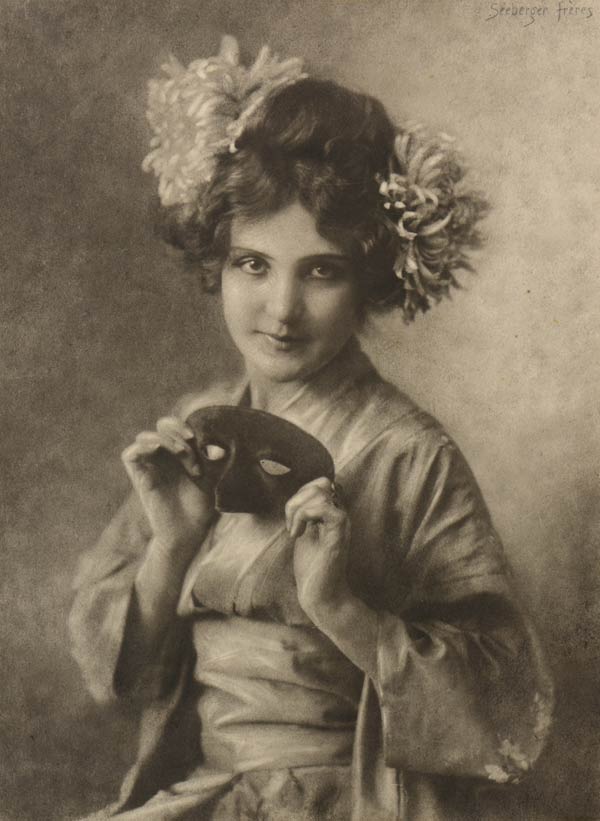
The photo above is from 1909 and was taken by the Séeberger brothers. They were three, Jules (1872-1932), Louis (1874-1946) and Henri (1876-1956) Séeberger, owners of an important photographic studio in Paris. Like the genre paintings, this photo has a name that is not the model’s name, she rather plays a “character”, an artist’s creation, called: Jeune femme au masque, “young girl with mask”. It falls into the category of pictorialists who were fond of exotic, mythological and religious themes. They liked retouching and interventions that brought photography very close to a neighbouring artistic realm of painting. It was most likely taken with an Eidoscope, not only for its flou artistique look and date, but also because it was the Séeberger brothers who gave the lens their famous aphorism: L’Eidoscope ne photographie pas, il dessine, “Eidoscope does not photograph, it draws “.
Artistic lenses
It is very interesting to observe how the discussion about lenses that intentionally did not do what was normally expected of a lens. This is worth a long quote from an article in the 1907 American publication Wilson’s Photographic Magazine.
“For years past opticians have been striving to eliminate the aberrations in lenses, and imdoubtedly the numerous improvements introduced during recent years in the construction of photographic lenses offer valuable advantages to the scientific, archaeological and technical photographer, through providing the means of obtaining perfect sharpness and mathematical exactitude. But it is quite otherwise for the artist, for whom these new qualities may be considered absolute defects, and opticians are now being encouraged to produce lenses which are not highly corrected, but which have in fact a certain amount of those very defects which they have hitherto striven to eliminate. By this means a desirable softness is obtained without flattening the picture”.
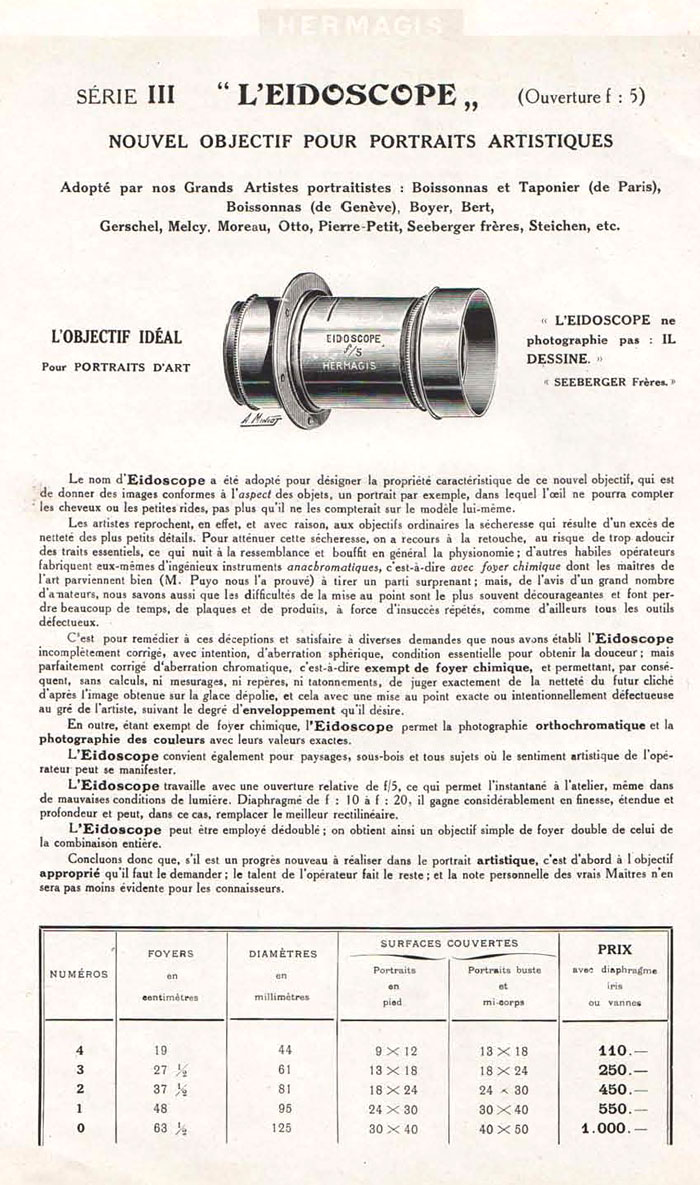
Eidoscope was a name constructed from the ancient Greek: εἶδος, eidos, means “form” and σκοπέω, skopéô, means “observer”. This suggests something like placing “form” no longer as an absolute and independent entity. It is breaking up a fundamental precept in photography, present in all its founding writings, including: ‘The pencil of Nature’ by William Henry Fox Talbot, for which in photography it is nature that depicts itself, regardless of human action or interpretation. Already in the name and concept Eidoscope introduces a subjectivity and the observer comes to the foreground: nature is what he sees, is how he sees it. This is essentially a tributary point of view of the Impressionist painting movement, which had a strong influence on pictorialist photographers.
In the text of the Hermagis catalog, reproduced above, we see precisely this argument being developed:
“The name Eidoscope was adopted to designate the characteristic property of this new lens, which is to produce images according to the appearance of objects. In a portrait, for example, the eye cannot count the hair or the small wrinkles, no more than one would tell them before the model itself. In fact, and rightly, artists disapprove, in ordinary lenses, the dryness that results from too much sharpness in the small details. To alleviate this dryness we have the retouching feature with the risk of softening the essential features too much, which compromises the resemblance and often fakes the physiognomy”
The pictorialists not only recovered some forgotten chemical procedures and invented others with many ways to interfere with the image through negative and positive retouching, but some even designed their own artistic lenses. This was the case of French photographer Émile Joachim Constant Puyo (1857–1933) who, together with Jean Leclerc Pulligny (1859–1939), both military engineers, designed and commissioned Darlot house a simple lens that also generated a soft focus effect and was marketed for a few years. However, this lens suffered from chemical focus and it is this point that the Hermagis catalog attacks in the next block of text by citing Puyo nominally.
“Other skilled operators make themselves ingenious chemically-focused, anachromatic instruments, with which the masters of art come up with surprising results (as M. Puyo proves), but we know that it is also the opinion of a large number of amateurs that focusing difficulties are the most frequent reasons for discouragement and waste of time, plates and products due to repeated failures, as is the case with all defective tools. It is to remedy this disappointment and to satisfy the various demands that we have launched Eidoscope, purposely incompletely corrected for spherical aberration, an essential condition for obtaining the smoothness, but perfectly corrected for chromatic aberration, that is, without chemical focus and thus allowing with no calculations, no measurements, no references, no groping, to judge exactly the sharpness of future photography to the artist’s liking and according to the degree of envelopment he wishes. In other words, being free of chemical focus, Eidoscope allows orthochromatic photography and color photography with exact values”.
To generate the artistique flou, Puyo-Pulligny went back to the times of lenses that not even color correction had. Its lens generated a blur, among other things, because of the natural different focal lengths for the different colors. This generated the trouble that the image seen by the photographer in the ground glass, influenced by the red to which our eyes are very sensitive, was not the one that would come from the developed negative, whose emulsion was more sensitive to the blue region. This difference between what the eye sees and what the emulsion registers in anachromatic (non-chromatically corrected) lenses forces the photographer, after focusing, to shift the lens or film to the optimal focusing distance. This is what is called the Chemical Focus. Hermagis understood this and used in its Eidoscope the spherical aberration to generate the flou, instead of chromatic aberration, thus leaving the photographer free of focus adjustments after focusing on ground glass. But even so, today, a Puyo-Pulligny lens is much prized by collectors and museums; they reach prices that only historical value and rarity can justify.
To wrap up with the instructive introduction text in the Hermagis catalog, these are its final considerations. With the exception of the technical points about the apertures and the separate use of the front and rear elements, there remains a more emotional approach about photographer’s “artistic feeling”, “talent” or “recognition”, which cannot be accomplished unless he buys an Eidoscope. The good old “sales talk” that manufacturers use and abuse to this day, whether it’s while offering the latest technology or colorful cameras with plastic lenses.
-Eidoscope also suits the landscapes, forests and all themes where the artistic feeling of the operator can manifest
-Eidoscope works with a relative aperture of f/5, which allows studio snapshots even in poor lighting conditions. Closed at f/10 or f/20 [see explanation of apertures scale below], it gains considerably in sharpness and depth of field and can replace the best rectilinear.
-Eidoscope can be used separately [front or rear element only], thus obtaining a single lens with twice the focal length of the complete combination.
Let us conclude that if there is further progress to be made in the artistic portraiture, it is by the proper lens that one must begin, the operator’s talent does the rest, and the personal mark of the true masters will be no less evident to the experts.
Soft Focus and pictorialism
Soft focus lenses were very important in establishing photography as a possibility of Art. The pictorialist movement, very active in both Europe and the United States, was instrumental in claiming this position. It would be very interesting to know for each image of the time which lens and which procedure was used. But it is impossible to establish a secure relationship between images and optics unless you have documented evidence, such as a photographer’s note, but these are very rare. For professional secrecy or for considering the information irrelevant to their audience, this information was not usually shared or even recorded. But as a category of lenses, represented by various makers and models, soft focus has been central to pictorial photography and, therefore, to the future of photography as a whole.
The artistic pictures of the late 19th and early 20th centuries were inspired by different sources in painting. There was a lot of religious or mythological themes. These were photos with models that, professionals or not, were there playing a role in the midst of a carefully produced or chosen scenario – as in the “girl with a mask” we saw at the beginning of this article. They were like tableau vivant records, dramatizations of a single static scene, prepared with great care and usually only for the amusement of the participants themselves and their friends, very fashionable in nineteenth-century elites. Due its motionless nature, tableaux vivants found their natural partner in photography. But this soon surpassed the function of mere registration of the event and the images came to be seen as autonomous works of art.
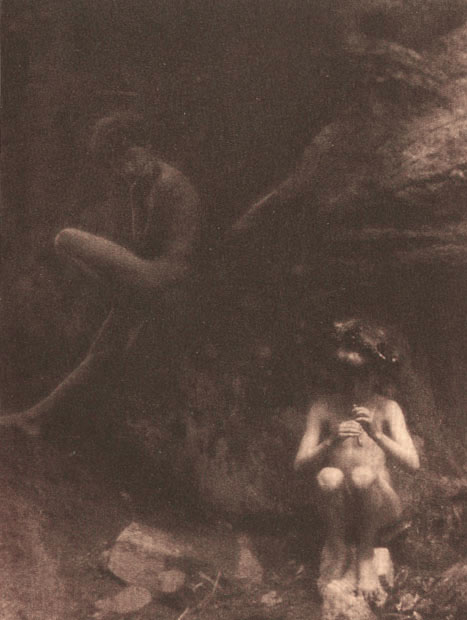
Photograph of a mythological scene created by the American photographer Clarence Hudson White (1871–1925), in 1905, with the title Pan Flute. Typically romantic theme and setting with a fundamental contribution of some soft focus lens. Pan, in Greek mythology, was the god of the woods, the herds, and the shepherds, all of them very dear to the territory of romanticism.
Another genre was landscapes that also owed a great deal to romantic painters like Caspar David Friedrich, or impressionists like James Whistler. Usually low light scenes depicting uninhabited, idyllic and mysterious places.
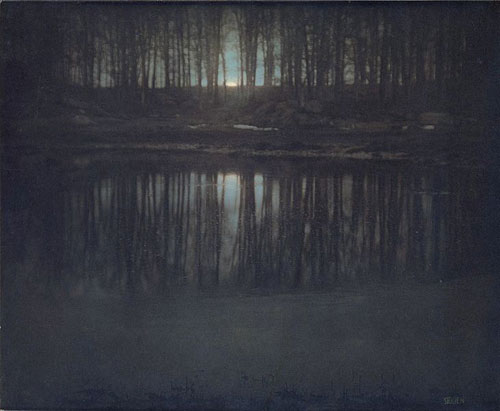

This photo is by Karl Schenker (1886–1954), a Romanian photographer who lived and worked in Berlin, Munich, New York, and London, an acclaimed portraitist. He had as a principle to photograph men with sharper lenses, such as a Tessar for example, for he considered that such crispy optics best accentuated masculine character. For his refined female clients he reserved the sweetness of his Eidoscope. Yes, he is a case in which we know he used a Hermagis Eidoscope a lot and did almost everything 18 x 24 cm. This size suited him well because he was also a skilled painter and extensively retouched his negatives to create backgrounds and clothes that were not even in the studio at the time of photography. Legend has it that he even covered a nude in a fur coat, purely with retouching, so as not to infuriate a distinguished lady’s husband (source: catalog of Karl Schenker’s exhibition at the Ludwig Museum in Berlin – Sep / 2016 – jan / 2017).
Still in the portrait class, it should be noted that there was a strong movement for the resumption of soft focus much later in the golden decades of Hollywood cinema when actors and actresses, and by a ripple effect clients of photo studios, generally enjoyed seeing themselves portrayed with diffused focus lenses and lighting effects. There were no more explicit references to painting, but instead it was developed an aesthetic of soft-focus photography. I believe that for this movement lenses like Wollensak’s Verito are more representative than Eidoscope.
This Eidoscope from SOM Berthiot
Like Hermagis, which has been reported as an optical manufacturer at least since 1845 (Agostini), Berthiot, founded by Claude Berthiot (1821 – 1896) in 1857, was also a traditional and successful firm and became , in the twentieth century, the largest French manufacturer of photography and cinema lenses. From 1913 it was called SOM, Société D’Optique et de Mécanique Berthiot, and in 1934 bought Hermagis. Almost nothing of the latter’s line continued in the SOM Berthiot portfolio, with the exception of some graphic lenses and the Eidoscope. Certainly due to the success of this flou artistique lens it was kept in the catalog at focal lengths 275, 375 and 480 mm, for half plate (13×18 cm), whole plate (18×24 cm) and 24×30 cm, respectively. The aperture had already gone from f/5 to f/4.5 during Hermagis’ time and was retained. The brass gave way to a black finish. At first, SOM Berthiot even retained the name Hermagis Paris in the Eidoscopes to capitalize on the good reputation such lenses enjoyed among photographers. This is what you see on the catalog page reproduced below.
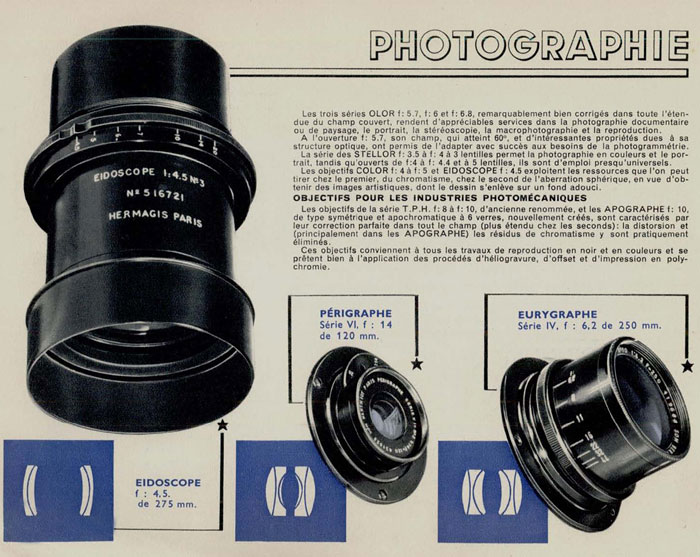
This Eidoscope I own already has SOM Berthiot Paris engraved and its finish is matte black over aluminum body. The paint is very thin and fragile. Any contact with any harder object peels it off. Unfortunately I found nothing about its year of manufacture based on serial number.

The diameter of the glasses is 6 cm and since it is an RR-type construction, see diagram in the catalog above, the tube, to give 275 mm, is a long one with 15 cm in total length. It has no anti-reflex treatment.

Although its viewing angle allows the format to be 13 x 18 cm, and although it is mounted on a Linhof Technika, also for half plate, I prefer using it with a 4×5″or 9×12 cm quarter plate reducing back. I think it’s more interesting for portraits. Hermagis catalog talks about landscapes and in this case yes, I think the 13×18 would be an interesting option.
A different aperture scale
Soon after the turn of the twentieth century it became a standard for all manufacturers to indicate f stops following the scale 2.8 – 4 – 5.6 – 11 – 16 – 22 – 32 … the first number, the largest aperture, could be anything, but the following began, from that time, invariably to fall on that sequence of numbers that indicated at each step half, or twice, the light admitted in the previous step.
However, for an Eidoscope-type soft focus lens this pattern would not make much sense with its use and purpose. Due to the possibility of adjusting the amount of spherical aberration, which generates the diffused focus, through the iris, in the sense that the closer the iris becomes, the sharper the image, since the time of Hermagis the aperture scale offered in Eidoscopes shorter steps than a full stop at the high aperture end. This makes perfect sense because anyone using an Eidoscope is probably interested in its softening effect.
These numbers, 4.5 – 5 – 6 – 7 – 10 – 14 and 20, are questioned in photography forums and I found different interpretations. So I decided to effectively measure the entrance pupil in each step and calculate the apertures in f numbers. I used the method described in this link. The results are represented in the image below. The top row are the numbers indicated on the lens ring and the bottom row the calculated apertures.

I was happy to know that no conversion table is required. The numbers shown on the lens ring, although not the same ones we are used to, correspond to the actual lens aperture calculated by the formula focal lengths / entrance pupil. We see from the figure above that the numbers, closely enough correspond to the actual openings. What Hermagis wanted and Berthiot maintained with this different system was to give the photographer greater control right in the region of the larger apertures.
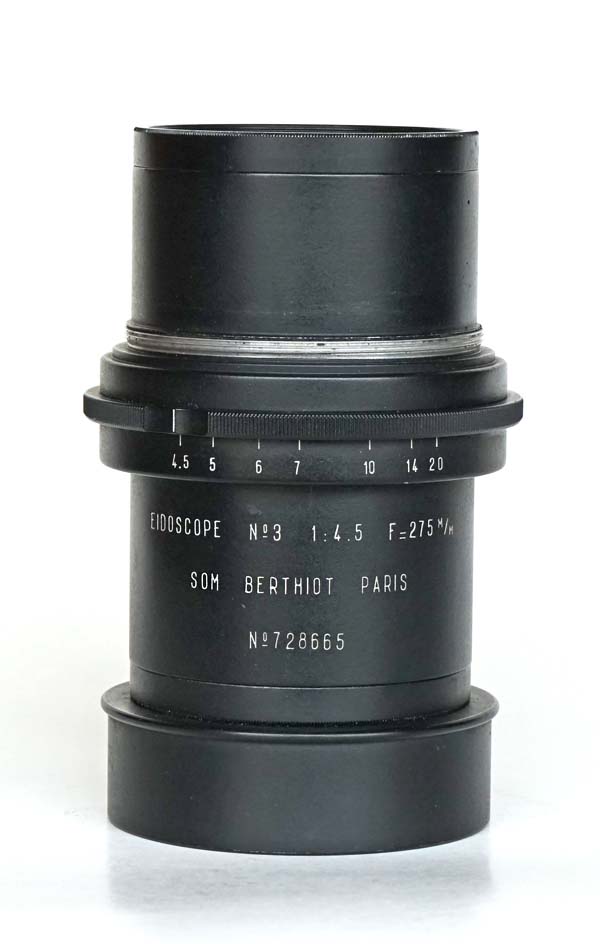
Instead of jumping from 4.5 to 5.6 and directly to 8, which would be almost two points, 4 times less light, it created four steps below f/8 With practice the photographer can learn to anticipate how much of the diffuse focus he will get on the final image. My experience is that just looking at the ground glass is very difficult to assess this effect. The most appropriate is actually to expose some plates/sheets and learn by observing the result.
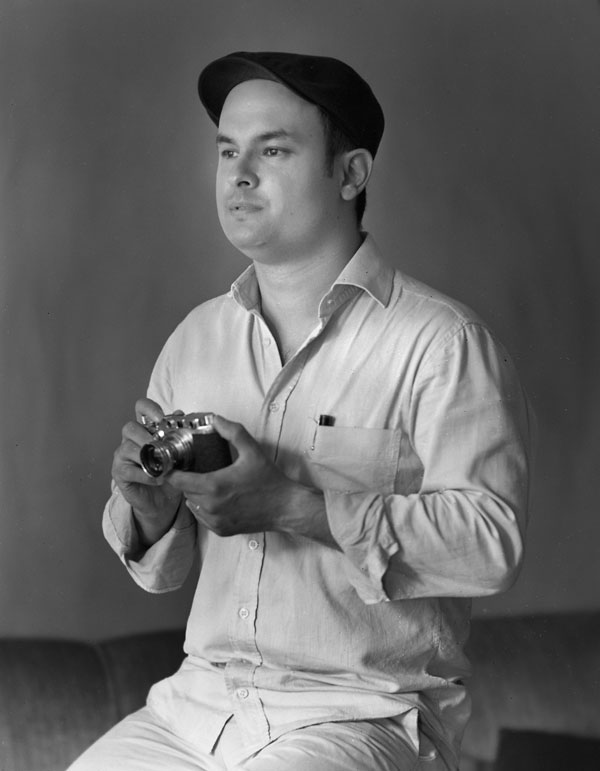
This photo, with photographer Ricardo Yamada, was made with f/10 and it can be observed that the flou is hardly present. It could be any RR lens. This is logical because it uses the spherical aberration to generate the soft focus and this type of aberration does not show up with small diaphragms precisely because spherical lenses behave very well near their central axis (for the mathematicians: where the sin of an angle almost equals the angle itself in radians)
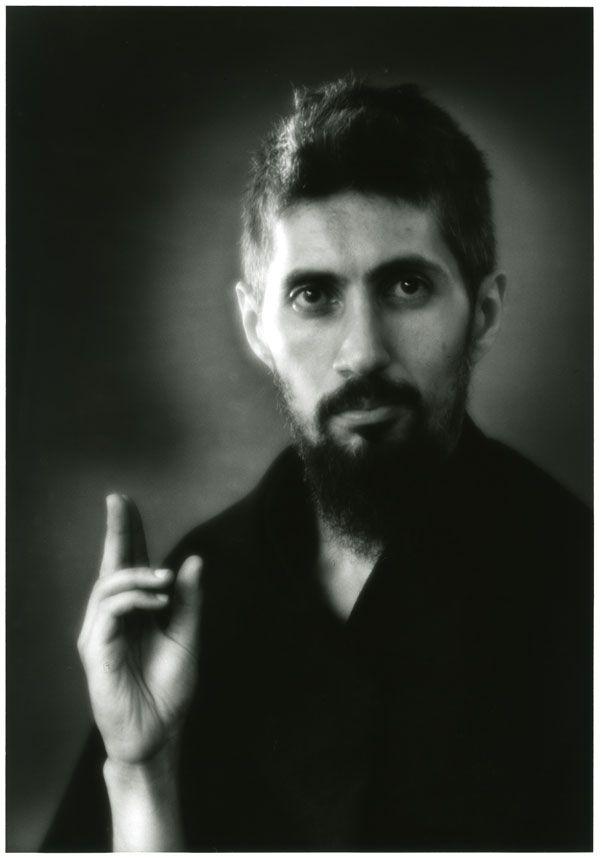
In this other example the opening was full: f/4.5. This photo, featuring photographer Rodrigo Silva as a model, makes intentional use of religious art references and uses some features on top of Eidoscope’s soft focus to create this atmosphere. At the enlarger, a mask was made to darken the background leaving a halo around the figure. The periphery received 2-4 times more light than the face. The hand, which was well lit by a large window received twice as much exposure than the face. An artificial side light from behind added that glow that enhances the Eidoscope halo, and finally the eyes had the catchlights highlighted with a spot reducer. It is therefore a current portrait with a recipe for interventions well suited to pictorialist photographers. The overall look and feel, but mostly the hand, came to me with an air of very delicate and pleasant Renaissance sfumato. In the midst of this softness all the artificially over-defined catchlights made an interesting counterpoint. The film was Forte 200 Tropical, developed in Pyrocat HD and the scan is from a copy on Ilford MG Fiber.
Some interesting links that were source of information used in this article:
Authored by Bernard Sulmon, this page in French from galerie-photo lists and compares various soft focus optics:
Bernard Sulmon, Objectif à flou artistique
Also from Galerie-photo a Dan Fromm’s page contains information about various Berthiot lenses and about the company itself:
Berthiot’s large format anastigmats
Antique & Classic Cameras page lists various soft focus lenses and is very rich in texts, catalog pages and other information:
An Illustrated Guide to Antique and Classic Soft Focus Lenses
